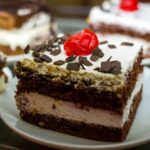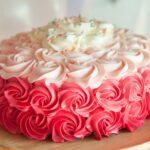Decorating a cake is a culinary art that requires precision, creativity, and the right tools. One essential tool in every baker’s arsenal is a cake decorating bag. Assembling this simple yet important tool properly is crucial for achieving beautiful designs and professional-quality cakes. Whether you’re a beginner or an experienced baker, understanding the importance of assembling a cake decorating bag is the first step towards creating stunning edible masterpieces.
A cake decorating bag, also known as a piping bag, allows you to control the flow of icing or buttercream onto your cakes with utmost precision. It gives you the ability to create intricate designs, add writing, make borders, and even craft delicate sugar flowers. However, if not assembled correctly, this versatile tool can cause frustration and lead to messy results.
In this article, we will guide you through the process of assembling a cake decorating bag from start to finish. We’ll discuss different types of bags available in the market and help you choose the one that suits your needs best.
Then, we’ll share a step-by-step guide on how to prepare your cake decorating bag for use. Additionally, we’ll discuss selecting the right piping tip for your design and provide tips on filling your bag with buttercream or royal icing efficiently.
By mastering the assembly process and understanding how to properly fill and grip your cake decorating bag, you’ll be equipped with the skills needed to create beautifully decorated cakes that will impress both yourself and others. Stay tuned for expert advice on various piping techniques such as writing, making flowers, borders, and more.
We will also cover troubleshooting tips for common issues that may arise during the decorating process. Lastly, we will explore proper cleaning and storage techniques to ensure longevity and optimal performance of your cake decorating bag.
So let’s dive into the world of cake decoration as we learn all about assembling a cake decorating bag – an indispensable skill for anyone aiming to create stunning baked creations.
Understanding the Different Types of Cake Decorating Bags
Cake decorating bags come in various types, each with its own benefits and uses. By understanding the different types of cake decorating bags available, you can choose the one that best suits your needs and preferences.
Disposable Plastic Bags
Disposable plastic bags are the most common type of cake decorating bag. They are affordable, convenient, and easy to use. These bags are made of thin plastic and are intended for single use. Disposable plastic bags are a great option for beginners or for those who prefer not to clean reusable bags after each use. They come in different sizes to accommodate various piping tips.
Reusable Fabric Bags
Reusable fabric bags are another popular choice among cake decorators. These bags are made of durable fabric such as canvas or polyester and can be used multiple times when properly cleaned. Reusable fabric bags provide better grip and control compared to disposable plastic bags. They also have the advantage of being more environmentally friendly.
Silicone Piping Bags
Silicone piping bags are a newer innovation in the world of cake decorating. These flexible, non-stick bags are highly durable and can withstand high temperatures, making them ideal for working with hot or thick materials such as melted chocolate or stiff buttercream. Silicone piping bags are also easy to clean and can be used repeatedly without any loss in performance.
When choosing a cake decorating bag, consider factors such as durability, ease of use, material compatibility, and your personal preferences. It’s also helpful to have a few different types on hand to suit different projects or icing consistencies. By selecting the right type of bag for your needs, you’ll be able to achieve professional-looking cake decorations with ease.
Step-by-Step Guide
Preparing your cake decorating bag properly is essential for achieving clean and precise designs on your cakes. Here is a step-by-step guide on how to prepare your cake decorating bag for use:
Step 1: Gather your materials
Before you begin, make sure you have all the necessary materials ready. This includes a cake decorating bag, piping tips, couplers (if needed), and your desired icing or buttercream. Having everything organized will make the process smoother and more efficient.
Step 2: Attach the piping tip
If you are using a piping tip that requires a coupler, attach the coupler to the inside of the bag first. Simply cut off a small portion of the bag’s tip, insert the coupler into the opening, and secure it by twisting on the ring.
If your piping tip does not require a coupler, simply insert it into the cut end of the bag. Make sure it fits snugly to prevent any icing from leaking out during piping.
Step 3: Fill the bag with icing
Scoop your desired icing or buttercream into a separate bowl or piping bag that has been fitted with a large round tip. Using this method will make it easier to transfer the icing into your cake decorating bag without making a mess.
Hold one hand around the top of the piping bag opening, creating some tension to help control the flow of icing. Use your other hand to scoop in a spoonful or two of icing at a time until it is about three-quarters full. Be careful not to overfill as this can cause excess pressure and lead to bursts or leaks.
Step 4: Secure and adjust
Twist the top of the cake decorating bag near where you filled it with icing to prevent any air bubbles from forming. This will ensure consistent pressure when piping. Gently squeeze and manipulate the bag until the icing reaches down towards the tip.
To test if you have prepared your cake decorating bag correctly, pipe a small amount of icing onto a test surface. If the flow is smooth and uninterrupted, you are ready to start decorating.
Properly preparing your cake decorating bag is crucial for achieving professional-looking results. By following these steps and taking your time with each stage, you will be well on your way to creating beautifully decorated cakes that will impress friends and family alike.
Selecting the Right Piping Tip for Your Design
Selecting the right piping tip for your cake design is an essential step in achieving professional-looking results. With a wide variety of piping tips available, it can be overwhelming to choose the one that will give you the desired effect. Here are some factors to consider when selecting the right piping tip for your design:
Design and Pattern
The first thing to consider is the design or pattern you want to create on your cake. Different piping tips produce different shapes and textures, so it’s important to know what effect you’re aiming for. For example, if you want to create rosettes or ruffles, a petal tip or ruffle tip would be suitable. If you’re looking to write on your cake, a writing tip would be more appropriate.
Size
Piping tips come in various sizes, indicated by numbers. The size of the tip will determine the thickness and size of the piped lines or shapes. Smaller tips like #1 or #2 are great for fine details and intricate designs, while larger tips like #10 or #12 are better suited for larger borders or covering large areas with icing.
Material
Piping tips can be made from different materials such as stainless steel or plastic. Stainless steel tips are more durable and long-lasting compared to plastic ones. They also provide better precision and control when piping. However, plastic tips may be more affordable and lightweight, making them a good option for beginners.
When experimenting with different piping tips, it’s important to practice on a test surface before applying them directly onto your cake. This will help you become familiar with how each tip works and how much pressure to exert when piping.
By carefully considering these factors and experimenting with different piping tips, you’ll be able to select the right one that suits your design needs and achieve beautifully decorated cakes every time.
Filling Your Cake Decorating Bag with Buttercream or Royal Icing
Once you have prepared your cake decorating bag for use, the next step is to fill it with buttercream or royal icing. The filling process requires some attention to detail and proper technique to ensure that the icing is evenly distributed and ready for piping.
To begin, prepare your icing by placing it in a piping bag fitted with your desired tip. Make sure that the icing is at the right consistency – not too thick that it won’t flow smoothly, but not too runny either. It should hold its shape when piped but still be easy to work with.
Next, twist the top of the bag to seal it and hold onto this twisted portion firmly between your thumb and index finger. This will create pressure when you squeeze the bag, allowing you to control the flow of icing as you pipe.
To fill the bag, hold it over a container or bowl with one hand while using your other hand to spoon or scoop the buttercream or royal icing into the open end of the bag. Be careful not to overfill – leaving about one-third of the bag empty will give you better control and minimize mess.
Once filled, untwist the top of the bag and gently squeeze from the twisted portion down towards the tip until a small amount of icing comes out. This helps eliminate air bubbles in your piping bag.
When filling multiple bags with different colored icings, make sure to clean out each bag thoroughly before switching colors. This will ensure that there are no unwanted color mixtures or residue left behind.
Now that your cake decorating bag is filled and ready to go, you can move on to practicing various piping techniques such as writing, creating flowers, borders, and more. With practice and patience, you’ll become more comfortable using a filled cake decorating bag and create beautiful designs on your cakes.
| Step | Instructions |
|---|---|
| 1 | Prepare the buttercream or royal icing at the right consistency. |
| 2 | Fill the cake decorating bag, leaving about one-third empty. |
| 3 | Squeeze a small amount of icing out to eliminate air bubbles. |
| 4 | Clean the bag thoroughly before switching to a different color. |
Proper Grip and Technique for Holding the Cake Decorating Bag
One of the key elements to successful cake decorating is having the proper grip and technique for holding the cake decorating bag. This may seem like a minor detail, but it can greatly affect the outcome of your designs. When you hold the bag correctly, you have better control over the flow and pressure of the icing, allowing you to create precise and beautiful decorations on your cakes.
To achieve a proper grip on your cake decorating bag, follow these steps:
- Hold the bag near the top: Start by gripping the bag near the top, where it is filled with icing. This allows you to easily control the flow and pressure, as well as make any necessary adjustments while decorating.
- Use your dominant hand: If you are right-handed, hold the bag with your right hand; if you are left-handed, use your left hand. This will give you better dexterity and control over your movements.
- Apply pressure with your palm: Place your palm against the back of the bag while using your fingers to guide and apply pressure. The firmness of your grip will vary depending on how thick or thin you want your lines or decorations to be.
- Practice steady movement: As you pipe, maintain a consistent speed and keep your movements steady. This will help create even and smooth lines or shapes.
By mastering the proper grip and technique for holding a cake decorating bag, you’ll be able to take your cake decorations to new heights. Practice makes perfect, so don’t get discouraged if it takes some time to get used to this skill. With patience and determination, you’ll soon find yourself creating stunning designs that will impress everyone who sees them.
Additional Tips
- Keep a relaxed grip on the bag – squeezing too tightly can cause discomfort or fatigue in hand muscles.
- Try different grips – experiment with holding the bag at different angles to find what feels most comfortable and allows for the best control.
- Use a turntable – if you’re finding it difficult to pipe while holding the bag, consider using a turntable. This allows you to rotate the cake while keeping the bag stationary, making it easier to pipe in different directions.
Mastering Different Piping Techniques
Once you have assembled your cake decorating bag and selected the appropriate piping tip, it’s time to start mastering different piping techniques. Whether you want to create elegant lettering on a cake, beautiful floral designs, or intricate borders, understanding these techniques is essential for achieving professional-looking results.
Writing
Writing on cakes can add a personal touch or convey a special message. To get started, make sure your piping tip has a small round opening for precise lines. Practice on parchment or wax paper before writing directly on the cake. Hold the bag at 90 degrees to the cake surface and apply even pressure as you guide the tip to form letters. Remember to keep a steady hand and maintain consistent pressure for smooth lines.
Flowers
Creating floral designs is one of the most popular cake decorating techniques. To pipe flowers, choose a petal-shaped piping tip that allows you to control the shape and size of each petal. Start by creating a base with a dot of icing in the center of your desired flower location. Then, working from the center outwards, pipe your petals in an overlapping pattern until you achieve the desired fullness and shape.
Borders
Borders are an effective way to enhance the overall appearance of a cake and give it a polished look. For simple borders like shells or beads, use a star-shaped piping tip with multiple small points. Hold the bag at an angle towards your body and apply steady pressure while moving in an even line along the edge of your cake. You can also experiment with more intricate borders like ruffles or braids using different tips and techniques.
Other Techniques
There are numerous other piping techniques you can master to expand your repertoire of cake decorations. These include basket weaving, lace patterns, rosettes, and figure piping. Each technique requires specific tips and practice to achieve the desired results. Explore tutorials and step-by-step guides online or in cake decorating books to learn these advanced techniques and bring your cake designs to the next level.
By mastering different piping techniques, you can create stunning cakes that are sure to impress. Remember, practice makes perfect, so don’t be discouraged if your first attempts don’t turn out flawlessly. With time and patience, you’ll become more skilled at manipulating the piping bag and achieving the desired shapes and patterns. Keep experimenting, learning, and refining your skills to become a true cake decorating artist.
Troubleshooting Tips
When it comes to cake decorating, even the most experienced decorators can encounter some common issues along the way. These issues can range from icing consistency problems to clogged tips, and they can be frustrating if you’re not sure how to fix them. In this section, we will discuss some troubleshooting tips for these common issues and provide solutions on how to fix them.
One of the most common problems that decorators face is inconsistent icing consistency. This can occur when your buttercream or royal icing is too thick or too thin. If your icing is too thick, it may be difficult to pipe smoothly or create intricate designs.
On the other hand, if your icing is too thin, it may not hold its shape well and could cause your design to collapse. To fix this issue, you can adjust the consistency of your icing by adding small amounts of liquid (such as milk or water) to thin it out or powdered sugar to thicken it up.
Another common issue that decorators encounter is clogged piping tips. This can happen when small debris or dried icing becomes stuck inside the tip, obstructing the flow of icing. To fix a clogged tip, you can try several methods.
Firstly, you can use a toothpick or a small brush to gently remove any debris from the tip. If that doesn’t work, you can soak the tip in warm soapy water for a few minutes before rinsing it thoroughly with clean water. Alternatively, you can also use a piping bag coupler system which allows for easy interchangeability of tips without removing them from the bag.
Here are some additional troubleshooting tips for other common cake decorating issues:
- If your flowers are wilting or drooping during piping, make sure that you are holding your bag at the right angle and applying consistent pressure.
- If your borders are uneven or shaky, practice maintaining steady pressure with your grip while piping.
- If your writing is smudged or messy, try using a smaller-sized piping tip and practice piping slowly and with control.
By following these troubleshooting tips, you’ll be able to overcome common issues that may arise during your cake decorating journey. Remember, practice makes perfect, so don’t get discouraged if you encounter some challenges along the way. With time and experience, you’ll become more confident in your cake decorating skills and be able to troubleshoot any issues that come your way.
| Common Issue | Solution |
|---|---|
| Inconsistent icing consistency | Adjust the consistency by adding liquid to thin it out or powdered sugar to thicken it up. |
| Clogged piping tips | Remove debris with a toothpick or brush, soak in warm soapy water, or use a piping bag coupler system. |
| Wilting or drooping flowers during piping | Hold the bag at the right angle and apply consistent pressure. |
| Uneven or shaky borders | Maintain steady pressure with your grip while piping. |
| Smudged or messy writing | Use a smaller-sized piping tip and practice piping slowly and with control. |
Cleaning and Storing Your Cake Decorating Bag
In order to ensure the performance and longevity of your cake decorating bag, it is crucial to properly clean and store it after each use. Cleaning your bag thoroughly will prevent any leftover icing or residue from drying and clogging the tip, leading to potential issues during your next decorating session. Here are some tips for effectively cleaning your cake decorating bag:
Firstly, carefully remove any excess icing or filling from the bag by scraping it out with a spatula or spoon. Be sure to scrape all the way down to the tip to remove any trapped particles.
Next, wash the bag with warm water and mild soap, both inside and out. Use a bottle brush or small cleaning brush to scrub away any stubborn stains or residue. Rinse the bag thoroughly to remove any soap residue.
After washing, hang the bag upside down or place it in a cup with the tip facing downward to allow it to air dry completely. Make sure there are no creases or folds in the bag that could create trapped moisture.
When storing your cake decorating bag, it is best to keep it in a cool and dry place away from direct sunlight. This will help prevent deterioration of the bag material and preserve its overall performance.
Additionally, you can consider investing in a storage case specifically designed for cake decorating bags. These cases usually have compartments for each individual component of the bag, keeping them organized and protected.
By following these cleaning and storing guidelines, you can extend the lifespan of your cake decorating bag, ensuring that it continues to deliver professional results for many baking projects to come. Taking proper care of this essential tool allows you to focus on honing your skills and creating beautiful designs without worrying about equipment malfunctions or failures.
Frequently Asked Questions
How do you set up a cake decorating bag?
To set up a cake decorating bag, you will first need to gather all the necessary supplies: a piping bag, a coupler, and a decorating tip of your choice. Start by trimming the end of the piping bag to create an opening that fits snugly around the base of the coupler. Slide the coupler into the bag with its narrow end facing outwards. Push it through until it reaches near the bottom of the bag.
Next, place your desired decorating tip on top of the coupler’s narrow end, ensuring it is securely attached. Gently twist on the ring of the coupler to hold everything in place tightly. Finally, fold down about one-third of the top part of the piping bag to create a cuff that helps keep icing from leaking out while you work.
How do you assemble a decorating bag with tips?
To assemble a decorating bag with tips, there are several steps involved. First, choose an appropriate decorating tip for your desired design and attach it to a coupler if necessary. Trim off enough of the piping bag’s tip so that when you insert the coupler inside, it is level with or slightly extends past this trimmed opening.
Insert the coupler into the piping bag through its trimmed end until it reaches near where you made your trim. From outside of the bag, hold onto both ends of the coupler and tighte-ning ring and give them a gentle twist together to secure them in place firmly within th-e ba-g. Now, fill your decorated ba-g with icing or buttercream by spooning or scooping it carefully into t-he cavity formed by th-e c-oupl-er an-d ba-g combinati-on-at approximately three-quarters full capacity – being careful not to overfill as this may lead to unwanted messes while icing later on.
How do you assemble a piping bag without a coupler?
Assembling a piping bag without using a coupler can be done quite easily adapt-ing to alter-nat-i-v-e meth-ods. To begin, select a piping tip suitable for your preferred design and examine its base size. Then, trim off the tip of the piping bag at a 45-degree angle. The opening should be slightly smaller than your chosen piping tip to ensure a snug fit.
Insert the trimmed end of the bag into the base of the decorating tip, pushing it gently but firmly upwards. You may need to provide some upward pressure on the opposite end of the tip to make sure it perforates through the icing bag smoothly. Once inserted, tug lightly on both ends of the piping bag and decorating tip to ensure they are securely held together. Your piping bag is now ready to be filled with icing or buttercream by placing it inside and spooning or scooping in your desired filling – keeping in mind not over-filling as it can cause difficulties in controlling the flow while decorating your cake or other baked goods.

Welcome to my blog about home and family. This blog is a place where I will share my thoughts, ideas, and experiences related to these important topics. I am a stay-at-home mom with two young children. I hope you enjoy reading it! and may find some helpful tips and ideas that will make your home and family life even better!





